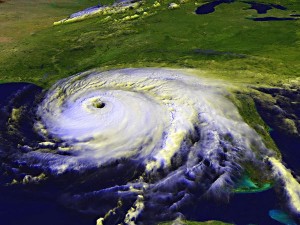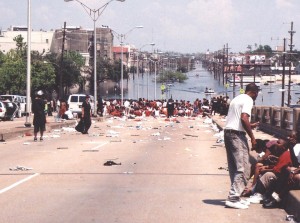FROM A DREAM TO A NIGHTMARE
Surviving Hurricane Katrina
by Mary Gehman
 Yesterday I wrote about how the Morpheus, the god of dreams, made my Mardi Gras dream come true. Today I turn my attention to the near-incomprehensible nightmare of Mary Gehman, a writer, researcher, publisher, and professor who tried to ride out Katrina in her Mid-City home, only to find herself embroiled in a week-long ordeal that hit most of the archetypal Katrina images: rising waters in the home, stranded on an overpass, lack of food and water while helicopters hovered doing nothing, hell at the Superdome, and a disorienting bus ride to destinations unknown.
Yesterday I wrote about how the Morpheus, the god of dreams, made my Mardi Gras dream come true. Today I turn my attention to the near-incomprehensible nightmare of Mary Gehman, a writer, researcher, publisher, and professor who tried to ride out Katrina in her Mid-City home, only to find herself embroiled in a week-long ordeal that hit most of the archetypal Katrina images: rising waters in the home, stranded on an overpass, lack of food and water while helicopters hovered doing nothing, hell at the Superdome, and a disorienting bus ride to destinations unknown.
I am taking a different approach with today’s review. This is not a book or even a published article. Mary (I’ll her first name because I feel like I know her intimately after this account) owns a small independent press, Margaret Media, and dedicated a page on its website to this 29 page, single spaced document.
I learned of Mary’s account Friday after heading to Slim Goodies to grab breakfast and finish a blog post. Tropical Storm Karen was still a day away from anticlimactic landfall and, though the sky was clear when I set out on my bike that morning, it was darkening when I left the diner after noon. Biking is a good way to get around this city, but when I have my computer strapped on my back I’m always afraid of wrecking (how crazy that I’m more afraid of the damage a car will do to my Macbook?!) or getting caught in a sudden shower. I thought rain would hold out the half hour I needed to get home but five minutes into my ride the outer bands suddenly hit and the skies opened up. As I pressed through the instant downpour I racked my brain for the nearest refuge, finally realizing that McKeown’s Books was only a few blocks away.
As I shot under the canopy, owner Maggie McKeown was outside breaking down a display. I was drenched and she invited me in to have a seat and dry off. Maggie is one of the most gentle and welcoming souls I’ve met since moving to town and, ironically, had been reading the post I’d just uploaded when the skies opened up.
As I checked on my computer–the case had done its job–I was excited to share my news about joining Morpheus. In turn, Maggie filled me in on some unknown fact about the desegregation of Mardi Gras and bonehead Krewes that quit parading rather than integrate. Eventually, the conversation turned to books and literature. She told me a friend of hers had documented her Katrina experience online and that it was one of the best accounts she’d read. Assuring me it was mind-boggling, she sent me the link.
Mary’s account turned out to be as gripping as promised.
This account is tight and focused–stripped of fancy prose to let the stark facts speak for themselves–but a lot happens in a few short days so it is a dense 29 pages that may take a couple of hours to digest effectively. She begins with her decision to stay in the city, but as predictions grow more dire she packs up her dogs and tries to flee. At this late hour, though, she cannot find an operating gas station anywhere and is forced to turn back or spend the storm stranded on a desolate stretch of I-10 east of New Orleans.
After surviving a frightening night, Mary awakens the next morning feeling justified for having stayed. It was a disturbing night, but she was at home with her dogs and could immediately start dealing with the limited damage. Then the water started creeping up the street.
I won’t tell Mary’s whole story, as she does it so effectively. I’ll just say every step is heart-wrenching and infuriating. Animal lovers will find it difficult to read the decision she must make to leave her two large dogs behind as she finds herself trapped on the second floor of her home. Once ‘rescued,’ she is unceremoniously dumped and forgotten on the Broad Street overpass where she and 300 other civilians do anything they can to survive while hovering helicopters and passing boats ignore them. Not to mention the sheriff deputies.
Perhaps most shocking here is that the bridge also housed prisoners from New Orleans Parish Prison guarded by deputies with strict orders to protect and preserve the prisoners–and no one else. Deputies were the only ones on that bridge with supplies, yet civilians were coldly ignored. At one point a man is arrested for stealing water and Mary comments that it is illegal to steal from police but not to watch civilians die of thirst.
After all the prisoners were evacuated days later, Mary led a desperate effort to collect pens and crayons from the abandoned civilians to make a giant sign to wave at passing boats and helicopters crying: HELP! DYING! Mary had to assure a member of the crowd that they didn’t have time or ink for politeness by adding PLEASE! Personally, I would have thought DUH! more appropriate.
 After four days, the nightmare continues at the Superdome, and every step of Mary’s journey astounds. I have read multiple accounts of Katrina but this is one of the most intimate and detailed first-hand accounts of this grand national cluster@#!$ I’ve encountered. You may ask why you would want to read yet another account of this tragedy, but I believe it is vitally important in a nation of short memories to remember the human face of systemic ineptitude and failure, especially as we are in the midst of a government down.
After four days, the nightmare continues at the Superdome, and every step of Mary’s journey astounds. I have read multiple accounts of Katrina but this is one of the most intimate and detailed first-hand accounts of this grand national cluster@#!$ I’ve encountered. You may ask why you would want to read yet another account of this tragedy, but I believe it is vitally important in a nation of short memories to remember the human face of systemic ineptitude and failure, especially as we are in the midst of a government down.
One of the most infuriating arguments I hear about Katrina is that people shouldn’t have expected the government to rescue them. This is callous absurdity at heights that would make Pontius Pilate himself do a double take. We can drop bombs in the mountains of Pakistan with unmanned drones. We can resupply space stations circling the earth. We can take to the skies and cross vast oceans in mere hours. Yet we can’t find buses and boats to rescue stranded, starving, dehydrated, and drowning citizens of the supposedly greatest nation on earth? We can supply an army in a two-front war but can’t drop food and water on our own soil as helicopters circle overhead? I fear these are lessons we still haven’t learned. It’s easy to dismiss failure when someone else suffers, but will you be so glib when it’s you drowning in your own attic in your own town where you thought this never could happen here?
Katrina was one of America’s most shameful hours. Everything from the levies to the abandoned masses could have been prevented. As the national conversation focuses more and more on the role of government heading forward, accounts like Mary Gehman‘s should serve as a brutal reminder. Are we going to move forward as a civilized nation that protects its own and stands a beacon to the world, or will we let this great nation crumble as we succumb to and–worse–tolerate, an ever-increasing litany of Katrina-style national washings of our hands.

Great review! And it’s a great article. I’ve read it a couple of times. Just one correction – the prisoners were from the New Orleans Parish Prison at the foot of the bridge – not Angola. Don’t remember, but some of them may have been going to Angola – not sure.
Thanks for your response! I’ll go back and correct that ASAP! Thought I read about Angola, but I’m also reading 9 Lives right now for next Monday and may have crossed my wires!!!
And I forgot to run Spell Check! Yikes! Get in a hurry, sometimes . . .